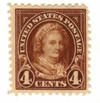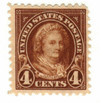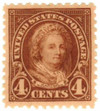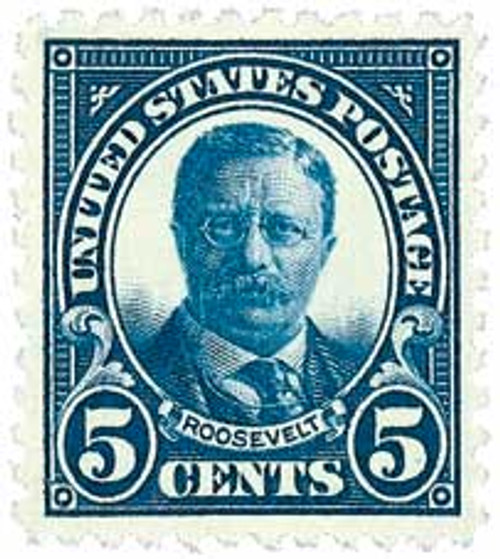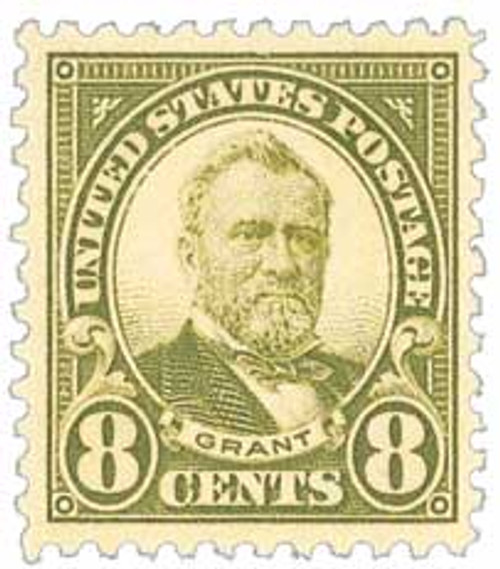
1923 4c Martha Washington, yellow brown
# 556 - 1923 4c Martha Washington, yellow brown
$0.70 - $365.00
U.S. #556
Series of 1922-25 4¢ Martha Washington
Flat Plate Printing
Series of 1922-25 4¢ Martha Washington
Flat Plate Printing
Issue Date: January 15, 1923
First City: Washington, DC
Quantity Issued: 573,378,277
Printed by: Bureau of Engraving and Printing
Printing Method: Flat plate
Perforation: 11 gauge
Color: Yellow brown
First City: Washington, DC
Quantity Issued: 573,378,277
Printed by: Bureau of Engraving and Printing
Printing Method: Flat plate
Perforation: 11 gauge
Color: Yellow brown
Martha Washington’s image was used on this stamp only a few years after women had won the right to vote. It was not the first time she appeared on a postage stamp (U.S. #306 in 1902), but it was another sign of a dramatic increase in representation of women in the government.
The Series of 1922-25
and the Wheels of Progress
and the Wheels of Progress
In 1847, when the printing presses first began to move, they didn’t roll – they “stamped” in a process known as flat plate printing. The Regular Series of 1922 was the last to be printed by flat plate press, after which stamps were produced by rotary press printing.
By 1926, all denominations up to 10¢ – except the new ½¢ – were printed by rotary press. For a while, $1 to $5 issues were done on flat plate press due to smaller demand.
In 1922, the Post Office Department announced its decision to issue a new series of stamps to replace the Washington-Franklin series, which had been in use since 1908. Many criticized the change, believing it was being made to satisfy collectors rather than to fill an actual need. However, the similar designs and colors of the current stamps caused confusion, resulting in a substantial loss in revenue each year. In busy situations, postal clerks could not tell at a glance if the correct postage was being used.
Postal employees requested a variety of designs that could easily be distinguished from one another. Great care was taken to make sure the new designs could not be confused. Although the frames are similar, the vignettes (central designs) are distinctive. Prominent Americans, as well as scenes of national interest, were chosen as subjects for the new series.
In addition to issuing new designs, the Department developed a plan to first distribute a small number of each stamp on a particular date in a selected town that was of historical and geographical significance to the subject. The plan greatly increased interest and began a new trend of collecting stamps on covers or envelopes postmarked on the first day of issue.
U.S. #556
Series of 1922-25 4¢ Martha Washington
Flat Plate Printing
Series of 1922-25 4¢ Martha Washington
Flat Plate Printing
Issue Date: January 15, 1923
First City: Washington, DC
Quantity Issued: 573,378,277
Printed by: Bureau of Engraving and Printing
Printing Method: Flat plate
Perforation: 11 gauge
Color: Yellow brown
First City: Washington, DC
Quantity Issued: 573,378,277
Printed by: Bureau of Engraving and Printing
Printing Method: Flat plate
Perforation: 11 gauge
Color: Yellow brown
Martha Washington’s image was used on this stamp only a few years after women had won the right to vote. It was not the first time she appeared on a postage stamp (U.S. #306 in 1902), but it was another sign of a dramatic increase in representation of women in the government.
The Series of 1922-25
and the Wheels of Progress
and the Wheels of Progress
In 1847, when the printing presses first began to move, they didn’t roll – they “stamped” in a process known as flat plate printing. The Regular Series of 1922 was the last to be printed by flat plate press, after which stamps were produced by rotary press printing.
By 1926, all denominations up to 10¢ – except the new ½¢ – were printed by rotary press. For a while, $1 to $5 issues were done on flat plate press due to smaller demand.
In 1922, the Post Office Department announced its decision to issue a new series of stamps to replace the Washington-Franklin series, which had been in use since 1908. Many criticized the change, believing it was being made to satisfy collectors rather than to fill an actual need. However, the similar designs and colors of the current stamps caused confusion, resulting in a substantial loss in revenue each year. In busy situations, postal clerks could not tell at a glance if the correct postage was being used.
Postal employees requested a variety of designs that could easily be distinguished from one another. Great care was taken to make sure the new designs could not be confused. Although the frames are similar, the vignettes (central designs) are distinctive. Prominent Americans, as well as scenes of national interest, were chosen as subjects for the new series.
In addition to issuing new designs, the Department developed a plan to first distribute a small number of each stamp on a particular date in a selected town that was of historical and geographical significance to the subject. The plan greatly increased interest and began a new trend of collecting stamps on covers or envelopes postmarked on the first day of issue.




